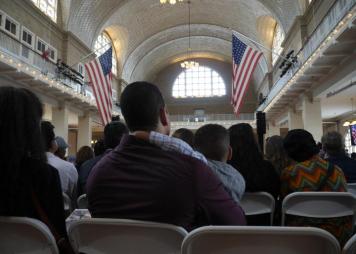Employment Still Affected by Immigration

The effects of slowing immigration in 2017 and through covid have been felt across all businesses, from locally owned shops to national retailers. While more immigrants are slowly being welcomed to the U.S. there is still a void to fill.
“You know what could be self-protective for us? To get some immigration reform. If we’re two and a half million workers short, 20% of produce in the Central Valley, bread-basket area didn’t get harvested because we have no labor. So we can help with inflation, but we’re going to need to do the hard things now,” Land O'Lakes CEO Beth Ford told TIME. “Investing to address that, including labor, is so critically important- and will help alleviate some of that cost pressure.”
The prevalent need for workers is not only causing an increase in food prices but also in manufactured goods, service costs and even delivery prices. According to an economic letter from the Federal Reserve Bank of San Francisco, lower immigration contributed to a tighter labor market where the vacancy to unemployment ratio, or job openings to the number of available workers, increased. Meaning that, there were not enough workers for all the positions across industries.
“Reopening of borders in 2022 and easing of immigration policies brought a sizable immigration rebound, which in turn helped alleviate the shortage of workers relative to job vacancies,” Evgeniya A. Duzhak , the letter’s author, explained. “If the pickup in immigration flows continues, it could further ease overall labor market tightness, albeit by a modest amount.”
Why Immigration Matters
Overall, a flow of immigrants matters because of the potential impending inflation and recession economists have predicted.
As Eric Levits described it for New York Magazine, “this historic labor shortage is propping up inflation as desperate employers raise wages to attract scarce workers, then boost prices to compensate for higher costs. Or at least this is what the U.S.’s top economic policy-makers believe.”
In addition, our aging population and low birth-rates are causing our country’s working-age population to dwindle. Lastly, the global market competition has our governments desiring to depend less on Asian markets and manufacture more within the U.S. All of these tangible issues can be solved with updated immigration policies.
And to those who worry about immigrants taking too many jobs, Ford speaks again of the basic farm jobs that need workers.
Will Immigrants Take My Job?
“They don’t take jobs [from Americans]. These jobs are hard. And I can tell you, I was just in Nebraska a couple nights ago speaking to a number of farmers- and our local retailers. It’s a crisis out here in terms of labor availability. What are we going to do? Something like 40% of the labor in agriculture are immigrants. Some of them are needed year-round. But certain visas are only seasonal visas. That doesn’t work. It’s very challenging to attract workers.”
For 2023, Congress has limited H-2B visas at 130,716. These visas are for international workers to fill seasonal positions in the U.S., not agricultural work. To-date U.S. employers have already requested 142,000 visas for the spring and summer seasons. Until there is a holistic approach to immigration reform the current employment and pricing issues will escalate.
There is hope for the immigrants currently living in the U.S. who may be eligible to become citizens. They could, through the appropriate process, request a family member who will become another needed worker to our economy. However, USCIS costs keep many immigrants from applying for their green card or citizenship at all. OPA understands the complexities of the citizenship process, and the need for immigrants in our nation. We welcome you to join our effort to make citizenship accessible to everyone.



